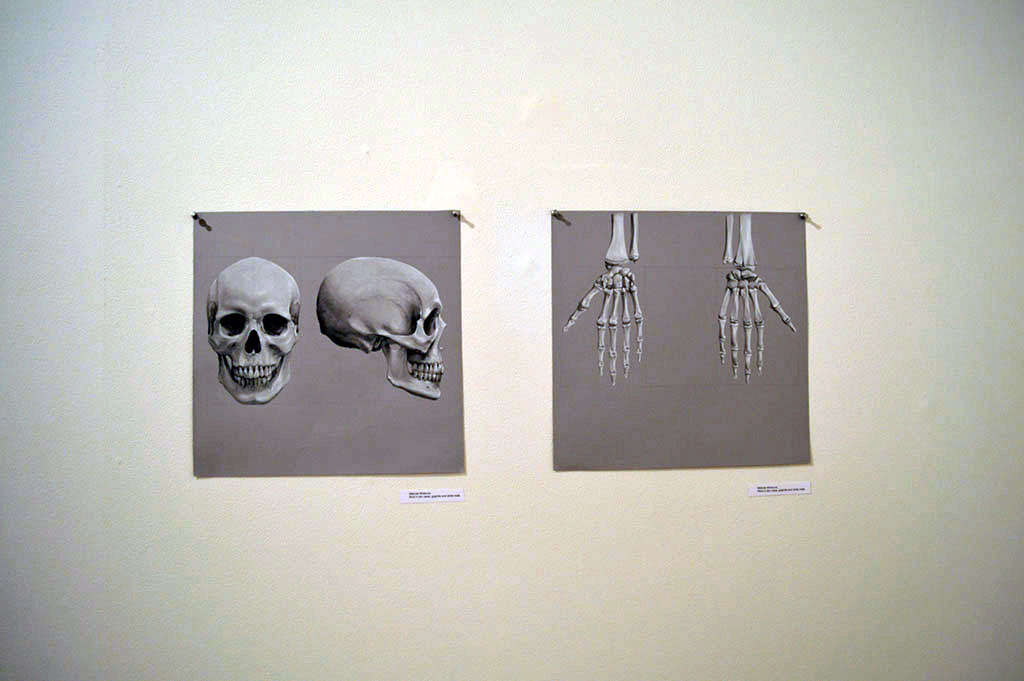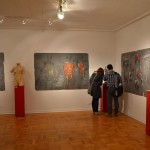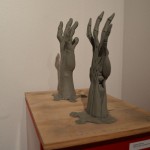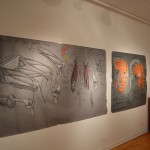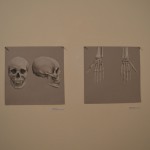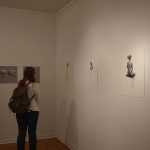By Lucy Vernasco
The International Museum of Surgical Science’s new Anatomy in the Gallery exhibit feels more like an immersion into the study of physiology than a walk through a classical art show. This is because the art displayed in Notes on Life: Visual Lectures from the Vitruvian Fine Art Studio, on view until Friday May 22nd, was created originally for classroom learning.
“The work for the exhibit is work that was not really meant to be exhibition style work. It’s actually classroom work” for anatomy classes, said Melinda Whitmore, one of the exhibit’s two artists. She teaches the classes at the Vitruvian Studio, 1735 N. Ashland Ave.
The exhibit includes clay sculptures, anatomical drawings in charcoal and pastel and graphite figure drawings. Created for anatomical teaching, they are lyrical as well as scientific.
“It’s a series of drawings and lecture demonstrations that were meant for teaching students and for getting them to think critically about anatomy structure and understanding how to construct a figure drawing. They’re visual lectures.”
Whitmore, co-founder and principle instructor of Vitruvian Fine Art Studio in Chicago, also teaches anatomy classes at the School of the Art Institute in Chicago and at Northwestern University’s Feinburg School of Medicine.The exhibit also features works by her husband, David Jamieson, who co-founded and instructs at Vitruvian Fine Art Studio.
The International Museum of Surgical Science, 1524 N. Lake Shore Dr., is the only museum in North America dedicated to the art and science of surgery, according to a press release. IMSS’s Anatomy in the Gallery series has celebrated the intersection of art and science since 1998.
“Surgery is an art form, as surgeons must make careful incisions and precise wound closures, so must an artist make specific decisions regarding their work,” said Justina Doyle, manager of education and events at IMSS.
Doyle contacted Whitmore and Jamieson after finding Vitruvian Fine Art Studio online.
“From their vibrantly colored anatomical drawings, to their anatomical sculptures and figure drawings, they are a very talented pair. I also enjoy the educational element of their work. The fact that they teach anatomical drawing and sculpture lessons at their studio and also to medical students is a nice tie-in to the Museum, as we are an educational institution,” Doyle said.
The anatomical sculptures, also called écorchés, evolved from Whitmore’s memory and imagination
“They’re all done out of my head. I don’t sculpt anything using models. I just do the figures using all the techniques that we teach students to understand using anatomy and how it applies to drawing and sculpture,” Whitmore said.

Whitmore and Jamiesons’ pieces fit well inside a museum housing historical surgical equipment, artifacts and portraits of pioneering doctors and nurses. Their art finds the intersection between art and science. Their visual lectures turn art inside out, by displaying the biological parts of the human body. Muscles are exposed, labeled and filled with bright orange pastel. Bones and joints are given depth and dimension.
“It’s important to understand what it is you’re looking at, and that your firm understanding of the subject matter from the inside out knowing that the external forms that are created, [and] what’s creating them.” Whitmore said. “Is it a fat pad? Is it a turn of the muscle? Or is it the projection of a bond? The more students can be empowered by this understanding, the better they are to recognize how to describe them through drawing and sculpture.”
James Barnes, a former biological anthropology student turned web illustrator, attended the exhibit’s opening reception last Friday.
“The anatomical studies were not only effective, but wonderful to absorb with a recreational eye, reminiscent of the first time you flip through an old Gray’s Anatomy book just to look at the drawings,” Barnes said. “Seeing the notes and random scribbles was a real treat; a reminder of the person behind the work, and the processes we don’t see enough of in the art world.”
The exhibit’s work gives a look into what happens inside Vitruvian Fine Art Studio and during the teaching process. Some of the charcoal portraits are incomplete and reflect the process of creation from a sketch to adding three dimensional shading. The professional models who posed for the portraits spent eight three-hour sessions with Whitmore and Jamiesons’ students, who learned how to incorporate proportional anatomy in drawing.
“Obviously a lot of them go unfinished because a bulk of the time that my husband, David, who did a lot of those drawings, would be going around in class and working with students on their own drawings, making people understand certain concepts or certain parts of the drawing process that he wanted to illustrate,” Whitmore said.
Notes on Life: Visual Lectures from the Vitruvian Fine Studio is an eye-opening experience for those who want to learn more about the artistry of anatomical science.
“Art and science can very much go hand and hand. There are things within art that I love that are quantifiable. That can be measured and can be understood and developed through the understanding of structure and proportion,” Whitmore said.
Museum admission: $15 for adults; $10 for students, seniors and members of the military; $7 for children over three; free on Tuesdays.

